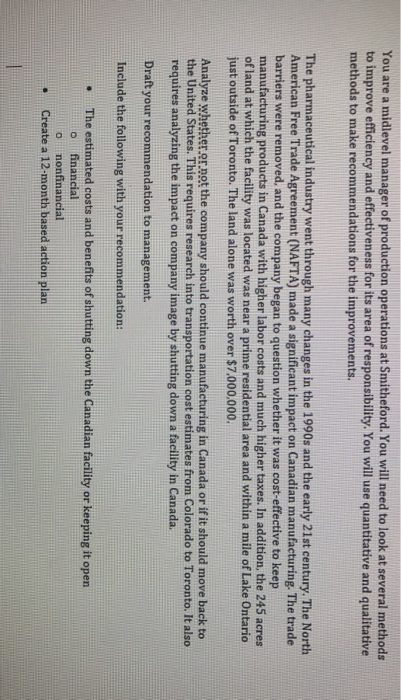*Please include sources thank you!

Smitheford Pharmaceuticals was founded by a former officer in the Civil War, General Robert Smitheford, in 1878. He moved his family to Colorado Springs to aid in his wife's tuberculosis condition. At the time, it was believed that the sunshine and high altitude had curative effects. The company quickly grew and expanded. To improve the economies of several growing towns in Colorado, General Smitheford built additional manufacturing facilities in Pueblo, Grand Junction, Fort Collins, and Durango, Colorado Smitheford was an excellent leader, as demonstrated by his rapid rise in the Union Army. He used management incentives and was an early follower of Frederick Taylor on methods improvement and employee satisfaction. The company has since adopted total quality management (TQM) philosophies but has done a poor job of implementing these principles in manufacturing I By the 1950s. Smitheford Pharmaceuticals grew to become the 6th-largest pharmaceutical firm in the United States. Expansion in manufacturing occurred in the 1970s and 1980s with operations in Canada. Puerto Rico, France, Japan, Mexico, and Brazil. Many challenges are facing the industry today. NAFTA impacted some advantages that Canadian manufacturing might have had. Stricter FDA guidelines have made transportation of partially manufactured products more complicated: drug interactions, especially for the elderly, can seriously affect whether or not to release a new product, and manufacturing equipment has become more sophisticated, and with the advanced technology comes increase fixed costs. You are a midlevel manager of production operations at Smitheford. You will need to look at several methods to improve efficiency and effectiveness for its area of responsibility. You will use quantitative and qualitative methods to make recommendations for the improvements. The pharmaceutical industry went through many changes in the 1990s and the early 21st century. The North American Free Trade Agreement (NAFTA) made a significant impact on Canadian manufacturing. The trade barriers were removed, and the company began to question whether it was cost-effective to keep manufacturing products in Canada with higher labor costs and much higher taxes. In addition, the 245 acres of land at which the facility was located was near a prime residential area and within a mile of Lake Ontario just outside of Toronto. The land alone was worth over $7.000.000. 2 0 Analyze whether.or.not the company should continue manufacturing in Canada or if it should move back to the United States. This requires research into transportation cost estimates from Colorado to Toronto. It also requires analyzing the impact on company image by shutting down a facility in Canada. Draft your recommendation to management. Include the ollowing with your recommendation: The estimated costs and benefits of shutting down the Canadian facility or keeping it open o financial o nonfinancial Create a 12-month based action plan Smitheford Pharmaceuticals was founded by a former officer in the Civil War, General Robert Smitheford, in 1878. He moved his family to Colorado Springs to aid in his wife's tuberculosis condition. At the time, it was believed that the sunshine and high altitude had curative effects. The company quickly grew and expanded. To improve the economies of several growing towns in Colorado, General Smitheford built additional manufacturing facilities in Pueblo, Grand Junction, Fort Collins, and Durango, Colorado Smitheford was an excellent leader, as demonstrated by his rapid rise in the Union Army. He used management incentives and was an early follower of Frederick Taylor on methods improvement and employee satisfaction. The company has since adopted total quality management (TQM) philosophies but has done a poor job of implementing these principles in manufacturing I By the 1950s. Smitheford Pharmaceuticals grew to become the 6th-largest pharmaceutical firm in the United States. Expansion in manufacturing occurred in the 1970s and 1980s with operations in Canada. Puerto Rico, France, Japan, Mexico, and Brazil. Many challenges are facing the industry today. NAFTA impacted some advantages that Canadian manufacturing might have had. Stricter FDA guidelines have made transportation of partially manufactured products more complicated: drug interactions, especially for the elderly, can seriously affect whether or not to release a new product, and manufacturing equipment has become more sophisticated, and with the advanced technology comes increase fixed costs. You are a midlevel manager of production operations at Smitheford. You will need to look at several methods to improve efficiency and effectiveness for its area of responsibility. You will use quantitative and qualitative methods to make recommendations for the improvements. The pharmaceutical industry went through many changes in the 1990s and the early 21st century. The North American Free Trade Agreement (NAFTA) made a significant impact on Canadian manufacturing. The trade barriers were removed, and the company began to question whether it was cost-effective to keep manufacturing products in Canada with higher labor costs and much higher taxes. In addition, the 245 acres of land at which the facility was located was near a prime residential area and within a mile of Lake Ontario just outside of Toronto. The land alone was worth over $7.000.000. 2 0 Analyze whether.or.not the company should continue manufacturing in Canada or if it should move back to the United States. This requires research into transportation cost estimates from Colorado to Toronto. It also requires analyzing the impact on company image by shutting down a facility in Canada. Draft your recommendation to management. Include the ollowing with your recommendation: The estimated costs and benefits of shutting down the Canadian facility or keeping it open o financial o nonfinancial Create a 12-month based action plan









